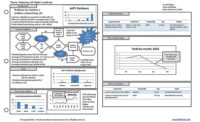I am fortunate to have had a lengthy career of more than 30 years. I have held a variety of product development positions, and these experiences have influenced my thinking about how best to get things done. No doubt, my perspective will continue to evolve with further experiences. For now, at least, my experience has led me to think that processes are not the be-all-end-all. We should guard against dogma.
The automotive industry has a standard for conducting product development projects. Known as the advanced product quality planning (APQP) process, it was created by the Automotive Industry Action Group to provide a framework for designing a new product and the process that will make that product. It’s important to have such a framework, because the skills needed to design a new product are different from the skills required to design a manufacturing process. Ideally, there should be plenty of exchanges between the design and manufacturing groups.
That said, we need not be slaves to the APQP process, either. That point was driven home during a recent product development project meeting. The customer had set a date for expected start of production (SoP). However, following the timeline estimates set forth in the APQP process would have delivered the product months after the customer’s expected SoP date.
The first thought to solve that problem might be to compress the duration of each of the various tasks detailed in APQP standard. However, this brings risks to the project. Changing the duration estimates for each task does not change how much time is actually needed to carry out those tasks. Such compression might give us the illusion that the project will produce the results in the desired time, but a good project manager must be more concerned with reality than illusion.
For this project, the manufacturing line was being developed at a site other than the final production location. When the line was completed, it would be torn down and transferred to the final location. The customer would qualify the product and the line at the final location via a run-at-rate and the production part approval process (PPAP). But, transferring the line would take time.
As a result, a proposal was made to run the new line at the development site to make a safety stock of qualified parts and thereby satisfy the customer’s expected SoP date. This would require a PPAP at the development site and, perhaps, an additional, shorter, PPAP after the line was transferred to the customer’s facility and restarted.
This seemed like a reasonable solution. However, the proposal was met with a prompt rebuttal: “This does not meet the automotive way.” Well, then, what exactly is the automotive way? Dogma.
Certainly, the typical approach to developing an automotive product is to have the final manufacturing line running at final production location for the PPAP. Ultimately, however, how the parts are made—with an approved production process and approved production tools—is more important than where the parts are made.
In an ideal world, there would have been only one manufacturing line setup and one production run start. Sometimes, that is not possible. In those cases, we need to think things through, balancing the needs of the customer and the risks. We should do this collaboratively with the customer to determine the best solution. Any approach to the work, even one that completely matches the APQP recommendations, will require customer sign off. That is, the customer can request or accept deviation from the standard. The APQP approach explicitly requires customer agreement.
Process standards were created to help us streamline planning, reduce risk, and ensure a measure of predictability and repeatability. The standard is not the reason for the work; the work is the reason for any standard. Invariably, circumstances will require us to adjust our product and process development practices to meet the needs of the moment.
Given the variation in the world, it is not practical to take a one-size-fits-all approach to a problem or to blindly follow a process. We should work with the customer, identifying risks and opportunities, and make prudent decisions that deliver the best result. I guarantee that there will be times when you will be required to modify a process or even abandon it. What that happens, work with your customer to find the best approach.



